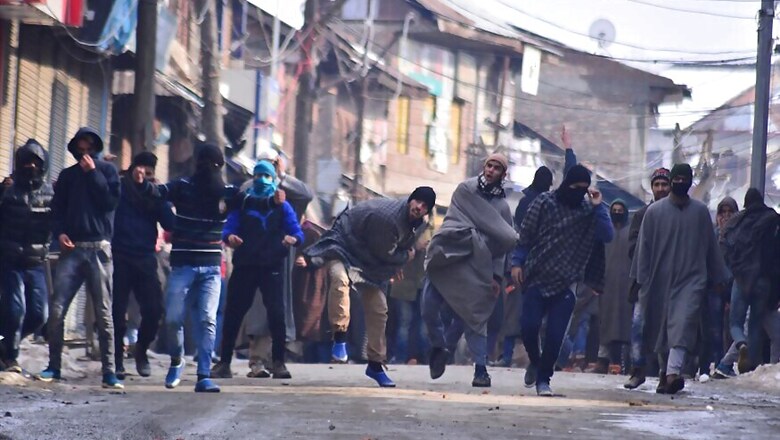
views
This piece is narrow in scope but, hopefully, broader in its message. It is about the importance of narratives surrounding Jammu and Kashmir. Armed conflict in the state is almost three decades old, and over the years it has changed in scale, scope and character. However, one essential characteristic remains constant — the recourse to violence by a significantly large section of the society.
Among the reasons ascribed to this violence are religious radicalisation, role of social media, youth alienation, Pakistan's proxy war and past political ineptness. None of these are incorrect but I think they do not sufficiently address the very basic nature of the stimulus which is today forcing the Kashmiris into violence.
Many noted scholars of ethnic conflict like Ted Robert Gurr and John Burton have talked about 'fear of the future' as a driver of conflict, and David Lake and Donald Rothchild have strongly argued that "intense ethnic conflict is most often caused by collective fears of the future."
This sentiment of fear is clearly playing out in the state of Jammu and Kashmir. In Kashmir it manifests in the separatists raising slogans of the Kashmiri Muslim identity being swamped by outsiders and therefore there is a great pull towards issues like the Amarnath agitation of 2008 and resistance to Pandit and Sainik colonies.
In Jammu, the fear of the Hindu minority becoming irrelevant is reflected in the protests against an inequitable division of resources, a sense of being ignored, particularly on the plight of the Kashmiri Pandits, and the fierce resistance to Rohingya refugee settlements. There is a somewhat similar sentiment, though not as strong, in Ladakh.
The dominant narrative throughout the state is that "your identity as an ethnic group is under threat". This is why Articles 370 and 35A are such emotive issues. Unless this emotion of fear is understood, it would be inexplicable for people in India to come out in even a small measure of support for a group which resorts to violence and calls for Azadi.
The youth are at the forefront of all agitations because they have the most to look forward to in the future. Their fear of future uncertainties cannot be dismissed by merely calling all of them as paid stone-pelters. I am not underplaying the past cost of the conflict which has taken a very heavy human cost and impacted on all facets of the society. While this is still relevant when it comes to whipping up emotions, if we have to seriously address the youth, it will only happen if we give them greater hope for the future.
Delhi must develop an effective counter-narrative. Unfortunately, efforts in this direction have been largely misdirected. The statements coming out from the government convey that there is no real problem in Kashmir, it being only restricted to a few districts; the youth are being misguided by the separatists, Pakistani handlers and the social media; demonetisation was an effective counter to the agitation of 2016. None of this is completely untrue but it underplays and oversimplifies a complex issue, and fails to address the root cause of the problem.
To be fair, there are the occasional positive statements by the Prime Minister and the Home Minister, and the appointment of the special representative, Dineshwar Sharma, was a big step. However, after the first visit of Sharma to the state, a high level meeting held by the Home Minister, of which Sharma was also a part, decided "to intensify operations" in the state. The strategy may be right but the timing and tenor of the message struck a discordant note and has made the special representative’s job much more difficult.
It is obvious that the narrative coming out of Delhi does not counter the narrative emanating from Kashmir. It only serves to reinforce it. It appears to justify what the Kashmiri people have been saying all along: 'The nature of our problem is not understood by Delhi'. Supported and fuelled by sections of the media on both sides, the two narratives are feeding off each other and exacerbating an already fragile situation.
The counter-narrative is simple — the government cares about the people of Jammu and Kashmir, irrespective of their religious identity, and will genuinely look for a solution to their problems. The message must be direct, simple and consistent. And it must be followed up by concrete steps taken towards conflict resolution. These steps are important because in this age of the social media we sometimes think that tweets and likes can replace action. It does not; social media can amplify an action but it cannot replace it.
A study by Eran Halperin, Daniel Bar-Tal, Rafi Nets-Zehngut and Erga Drori, Emotions in Conflict: Correlates of Fear and Hope in the Israeli-Jewish Society, starts with this paragraph, "Intractable conflicts are prevalent worldwide and in all of them emotions play an important role... Some of these emotions fuel the conflict and prevent its peaceful resolution, while others are necessary to embark on the road of peace. In the first category, fear is a most central emotion, while in the other one hope best symbolizes the attempt to change and opt for peace."
The kinetic fight, the killing of terrorists and the clampdown on terror funding is important. The state cannot succumb to threats of violence. But there is also the war of ideas to be fought and this is more important. The fear among the population has to be replaced by hope if we are to move towards some solution. It will be a long drawn-out process but let us at least start by sending out the right message which generates confidence and faith in all the people of Jammu and Kashmir.
— (The author is former Northern Commander, Indian Army, under whose leadership India carried out surgical strikes against Pakistan in 2016. Views are personal.)




















Comments
0 comment